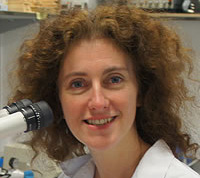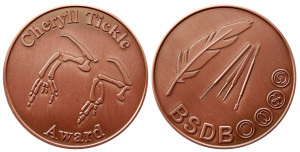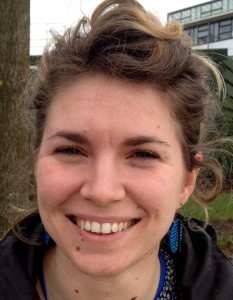The joint BSDB/BSCB spring meeting has yet again been a great and most successful event. As every year most of our Awards are announced on this meeting and the BSDB would like to congratulate all prize winners and awardees.
Quick Access – Waddington | C Tickle | Beddington | Summary
Enrico Coen: winner of the 2016 BSDB Waddington Medal
 The BSDB is delighted to announce Enrico Coen CBE FRS (John Innes Centre, Norwich) as the 2016 winner of theWaddington Medal. Professor Coen was awarded the medal for his pioneering contributions to understanding patterning and morphogenesis in plants, particularly snap dragon flowers. His work elegantly combines molecular genetics, diverse imaging techniques and computational modeling (see the Coen lab site). He is also well known for his popular science books ‘The art of genes’ (1999) and ‘Cells to civilisations’ (2012), and his painting, which has appeared on the cover of Cell and the walls of the Royal Society.
The BSDB is delighted to announce Enrico Coen CBE FRS (John Innes Centre, Norwich) as the 2016 winner of theWaddington Medal. Professor Coen was awarded the medal for his pioneering contributions to understanding patterning and morphogenesis in plants, particularly snap dragon flowers. His work elegantly combines molecular genetics, diverse imaging techniques and computational modeling (see the Coen lab site). He is also well known for his popular science books ‘The art of genes’ (1999) and ‘Cells to civilisations’ (2012), and his painting, which has appeared on the cover of Cell and the walls of the Royal Society.
The medal talk was a pleasure to watch and is now available on YouTube. It was a scholarly masterpiece of conceptual brilliance, presented with inspiring enthusiasm, enriched with beautiful images, illustrated with enlightening and entertaining movies of pottery (!!!) and computer models, and even spiced up with live experiments.It will soon be available on the BSDB’s YouTube channel. An interview performed by Cat Vicente during the Spring meeting is scheduled to be published in Development.
The Cheryll Tickle Medal revealed
 As reported previously, the BSDB has introduced the Cheryll Tickle Medal, awarded annually to a mid-career, female scientist for her outstanding achievements in the field of Developmental Biology. The BSDB is proud to announce the inaugural awardee Abigail Saffron Tucker who gave her outstanding and memorable Cheryll Tickle Award Lecture which can be watched on YouTube. To read more about Abigail, please download the BSDB Newletter 2015 or go to the post on The Node.
As reported previously, the BSDB has introduced the Cheryll Tickle Medal, awarded annually to a mid-career, female scientist for her outstanding achievements in the field of Developmental Biology. The BSDB is proud to announce the inaugural awardee Abigail Saffron Tucker who gave her outstanding and memorable Cheryll Tickle Award Lecture which can be watched on YouTube. To read more about Abigail, please download the BSDB Newletter 2015 or go to the post on The Node.
 On this occasion, for the first time the actual medal was revealed, which was designed by Andreas Prokop and Megan Davey in discussion with Cheryll Tickle. It shows the famous digit aberrations that occur upon transplantation/manipulation of the zone of polarizing activity (ZPA) or implantation of beads soaked in retinoic acid or sonic hedgehog (for details see Towers & Tickle, 2009, Int J Dev Biol 53, 805ff.). Cheryll performed much of this work in chick as illustrated by the feather on the medal’s flip side, which also shows the typical tool set required for experimental operations and the BSDB logo depicting in ovo development from egg to embryo.
On this occasion, for the first time the actual medal was revealed, which was designed by Andreas Prokop and Megan Davey in discussion with Cheryll Tickle. It shows the famous digit aberrations that occur upon transplantation/manipulation of the zone of polarizing activity (ZPA) or implantation of beads soaked in retinoic acid or sonic hedgehog (for details see Towers & Tickle, 2009, Int J Dev Biol 53, 805ff.). Cheryll performed much of this work in chick as illustrated by the feather on the medal’s flip side, which also shows the typical tool set required for experimental operations and the BSDB logo depicting in ovo development from egg to embryo.
Elena Scarpa: the BSDB Beddington Medal winner
 The BSDB is proud to announce the 2016 Beddington Medal winner Elena Scarpa. Elena studied in Turin (Italy), went for her Wellcome Trust fellowship-funded PhD project to the laboratory of Roberto Mayor (UCL, London), and works now in the group of Benedicte Sanson (Univ. Cambridge) on the role of mechanical tension in orienting cell divisions in the Drosophila embryo. Her Beddington Medal talk described the outcome of her successful PhD project (submitted in April 2015) and was entitled “Cadherin switch during EMT in neural crest cells leads to contact inhibition of locomotion via repolarisation of forces”. Elena introduced her project with the following words: “Contact Inhibition of Locomotion (CIL) was discovered by Abercrombie and colleagues over 60 years ago as the process through which migrating cells move away from each other after cell-cell contact. More recently, it has been shown to play important roles in vivo during morphogenesis and cancer invasion, but its molecular mechanisms have not been elucidated. In all systems where it has been investigated, the CIL response seems to rely on cell-cell contact dependent signalling. In particular, Eph-Ephrin signalling has been found to be responsible for CIL in cancer cells and in neurons, while in neural crest Wnt-PCP and N-Cadherin dependent cell-cell adhesion are required for CIL. However, it remained unclear why certain cells display an efficient CIL response while many other cell types do not exhibit CIL and instead remain in contact after cell collision, thus forming a stable cell-cell adhesion. During my PhD, I undertook a comparative approach to pursue this mechanism and ask why some cells exhibit CIL, while others, like epithelial cells, remain in contact and form stable junctions.”
The BSDB is proud to announce the 2016 Beddington Medal winner Elena Scarpa. Elena studied in Turin (Italy), went for her Wellcome Trust fellowship-funded PhD project to the laboratory of Roberto Mayor (UCL, London), and works now in the group of Benedicte Sanson (Univ. Cambridge) on the role of mechanical tension in orienting cell divisions in the Drosophila embryo. Her Beddington Medal talk described the outcome of her successful PhD project (submitted in April 2015) and was entitled “Cadherin switch during EMT in neural crest cells leads to contact inhibition of locomotion via repolarisation of forces”. Elena introduced her project with the following words: “Contact Inhibition of Locomotion (CIL) was discovered by Abercrombie and colleagues over 60 years ago as the process through which migrating cells move away from each other after cell-cell contact. More recently, it has been shown to play important roles in vivo during morphogenesis and cancer invasion, but its molecular mechanisms have not been elucidated. In all systems where it has been investigated, the CIL response seems to rely on cell-cell contact dependent signalling. In particular, Eph-Ephrin signalling has been found to be responsible for CIL in cancer cells and in neurons, while in neural crest Wnt-PCP and N-Cadherin dependent cell-cell adhesion are required for CIL. However, it remained unclear why certain cells display an efficient CIL response while many other cell types do not exhibit CIL and instead remain in contact after cell collision, thus forming a stable cell-cell adhesion. During my PhD, I undertook a comparative approach to pursue this mechanism and ask why some cells exhibit CIL, while others, like epithelial cells, remain in contact and form stable junctions.”
The details of this research are described in her 2015 publication entitled “Cadherin Switch during EMT in Neural Crest Cells Leads to Contact Inhibition of Locomotion via Repolarization of Forces” (Dev Cell 34, 421-34), and The Node has posted an interview with Elena.
Summary of all BSCB/BSDB awards
Medal Awards
- BSDB Waddington Award winner: Enrico Coen CBE FRS (John Innes Centre, Norwich) who gave a talk about his pioneering contributions to understanding patterning and morphogenesis in plants (available on YouTube), and an interview will be published soon in Development.
- BSCB Hooke Award winner: Thomas Surrey (Crick) who presented the lecture “Microtubule cytoskeleton dynamics: mechanistic insight from reverse engineering” that is available on YouTube. See more information about Thomas here.
- BSCB WICB Award winner: Lidia Vasilieva (Dept Biochem., Univ. Oxford, Oxford) who presented the talk “Towards understanding mechanisms of gene expression” that is available on YouTube. Read more information about Lidia here.
- The BSDB Cheryll Tickle Medal winner: Abigail Saffron Tucker who gave her Cheryll Tickle Award Lecture about the evolution of shape available on YouTube. To read more about Abigail, please download the BSDB Newletter 2015 or go to the post on The Node.
- BSDB Beddington Award winner: Elena Scarpa (now Univ. Cambridge in the group of Benedicte Sanson) for her work entitled “Cadherin switch during EMT in neural crest cells leads to contact inhibition of locomotion via repolarisation of forces” which was performed in the laboratory of Roberto Mayor (UCL).
PhD Poster Prizes
- 1st BSDB PhD Poster Prize winner (visit to 2016 SDB-ISD meeting, Boston): Mathew Tata (University College London, group of Christiana Ruhrberg) – P117 “Regulation of embryonic neurogenesisi by germinal zone vasculature” – see interview in The Node.
- 1st BSCB PhD Poster Prize winner (visit to 2016 ASCB meeting, San Francisco): Emma Stewart (University of York) – P65 “RNA-dependent localisation of the nuclear matrix protein CIZ1 to the inactive X chromosome“
- 2nd BSDB PhD Poster Prize (£75 cash prize): Laura Martin-Coll (DanStem, University of Copenhagen) – P87 “A single-cell analysis of progenitor heterogeneity at the onset of pancreas formation“
- 2nd BSCB PhD Poster Prize (£75 cash prize): Alex Pool (Barts Cancer Institute, Queen Mary University) – P56 “DDR1 localisation to adherens junctions prevents efficient clustering of supernumerary centrosomes“
- 3rd BSDB PhD Poster Prize (£50 cash prize): Leila Thuma (University of Bristol) – P159 “Modelling immune cell diapedesis from vessels to wounds in the Drosophila pupal wing veins“
- 3rd BSCB PhD Poster Prize (£50 cash prize): Saroj Saurya (Oxford University) – P74 “Drosophila Ana1 stabilises centrioles and also promotes centriole elongation in a dose-dependent manner“
Postdoc Poster Prizes
- Joint 1st BSDB Prize (£150 cash prize): Guilherme Costa (University of Manchester) – P144 “Cellular localisation of mRNA during angiogenesis”
- Joint 1st BSDB Prize (£150 cash prize): Sophie Gilbert (University of Oxford) – P29 “How the worm completes its skin“
- 1st BSCB Prize (£300 cash prize sponsored by MDPI): Dimitra Aravani (University of Leicester) – P104 “HHIPL1: a new gene that promotes atherosclerosis“
- 2nd BSDB Prize (£125 cash prize): Filip Wymeersch (MRC Centre for Regenerative Medicine, University of Edinburgh) – P134 “Transcriptionally dynamic neuromesodermal progenitors coexist alongside a stable niche during axis elongation“
- 2nd BSCB Prize (£75 cash prize): Kyojiro Ikeda (Sir Dunn School of Pathology, University of Oxford) – P141 “PTEN regulates CDC42-dependent morphogenesis through beta-arrestin1/ARHGAP10 signalling“
- 3rd BSCB Prize (£50 cash prize): Amy Barker (Queen Mary University of London) – P18 “Characterising intracellular trafficking of Junctional Adhesion Molecule C (JAM-C)“
Others
- The BSCB Science writing Prize winner (chosen by Barbara Melville; @keyeri) is Girisaran Gangnatharan (PhD student, Montpellier) for an essay about zebra fish models of regeneration entitled “Heart disease: fishing for a cure“
- The BSCB Image Award winners are:
- Anna Franz (School Biochem, Univ Bristol)
- Ronan Mellin (IGMM, Human Genetics Unit, Edinburgh)
- Helen Weavers (School Biochem, Univ Bristol)
Quick Access – Waddington | C Tickle | Beddington | Summary
